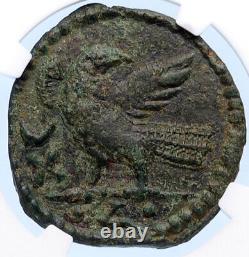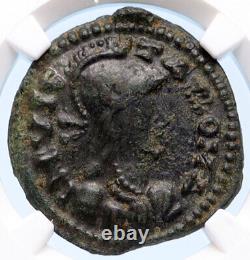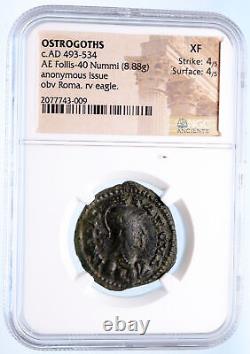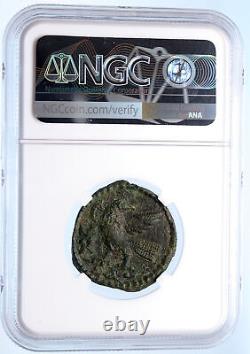
- Homepage
- Certification
- Composition
- Denomination
- Ae Prutah (34)
- Ae3 (14)
- Antoninianus (104)
- Ar Denarius (42)
- Aurelianianus (12)
- Aureus (145)
- Bi Double Denarius (24)
- Bi Nummus (22)
- Centenionalis (16)
- Cistophorus (24)
- Denarius (1270)
- Double Denarius (63)
- Dupondius (16)
- Nummus (119)
- Prutah (27)
- Quadrigatus (13)
- Sestertius (127)
- Siliqua (15)
- Solidus (169)
- Tetradrachm (21)
- Other (604)
- Era
- Ruler
- Antoninus Pius (53)
- Augustus (141)
- Caracalla (53)
- Constantine I (57)
- Constantine Ii (29)
- Domitian (58)
- Gallienus (37)
- Gordian Iii (62)
- Hadrian (100)
- Marcus Aurelius (69)
- Nero (113)
- Nerva (31)
- Philip I (66)
- Septimius Severus (35)
- Severus Alexander (69)
- Theodosius Ii (32)
- Tiberius (69)
- Trajan (97)
- Trajan Decius (28)
- Vespasian (76)
- Other (1606)
- Year
OSTROGOTHS Municipal Coinage of ROME Ancient 493AD Roman Style Coin NGC i68157






Municipal coinage of Rome Bronze Follis (40 Nummi) 26mm (8.88 grams) Rome mint, struck circa 493-534 A. Reference: BMC Vandals 14; Kraus -; MIB 74a (Theoderic and Athalaric); MEC I, 101; Metlich 76b (Theoderic) Certification: NGC Ancients. XF Strike: 4/5 Surface: 4/5 2077743-009 INVICTA ROMA, Helmeted and cuirassed bust of Roma right. Eagle standing left, head right, with spread wings, value mark XL to left; officina mark. The Ostrogoths (Latin: Ostrogothi, Austrogothi) were the eastern branch of the later Goths (the other major branch being the Visigoths).
The Ostrogoths traced their origins to the Greutungi - a branch of the Goths who had migrated southward from the Baltic Sea and established a kingdom north of the Black Sea, during the 3rd and 4th centuries. They built an empire stretching from the Black Sea to the Baltic. The Ostrogoths were probably literate in the 3rd century, and their trade with the Romans was highly developed. Their Danubian kingdom reached its zenith under King Ermanaric, who is said to have committed suicide at an old age when the Huns attacked his people and subjugated them in about 370. After their annexation by the Huns, little is heard of the Ostrogoths for about 80 years, after which they reappear in Pannonia on the middle Danube River as federates of the Romans.After the collapse of the Hun empire after the Battle of Nedao (453), Ostrogoths migrated westwards towards Illyria and the borders of Italy, while some remained in the Crimea (where the Crimean Ostrogoths existed as a distinct people until at least the 16th century). During the late 5th and 6th centuries, under Theodoric the Great most of the Ostrogoths moved first to Moesia c. 475-488 and later conquered the Kingdom of Italy of the Germanic warrior Odoacer. In 493, Theodoric the Great established a kingdom in Italy. A period of instability then ensued, tempting the Eastern Roman Emperor Justinian to declare war on the Ostrogoths in 535 in an effort to restore the former western provinces of the Roman Empire.
Initially, the Byzantines were successful, but under the leadership of Totila, the Goths reconquered most of the lost territory until Totila's death at the Battle of Taginae. The war lasted for almost 20 years and caused enormous damage and depopulation of Italy. The remaining Ostrogoths were absorbed into the Lombards who established a kingdom in Italy in 568. The Ostrogothic Kingdom, officially the Kingdom of Italy (Latin: Regnum Italiae), was established by the Ostrogoths in Italy and neighbouring areas from 493 to 553.
In Italy the Ostrogoths, led by Theoderic the Great, killed and replaced Odoacer, a Germanic soldier, erstwhile-leader of the foederati in Northern Italy, and the de facto ruler of Italy, who had deposed the last emperor of the Western Roman Empire, Romulus Augustulus, in 476. Under Theoderic, its first king, the Ostrogothic kingdom reached its zenith, stretching from modern France in the west into modern Serbia in the southeast. Most of the social institutions of the late Western Roman Empire were preserved during his rule. Theodoric called himself Gothorum Romanorumque rex ("King of the Goths and Romans"), demonstrating his desire to be a leader for both peoples.
Starting in 535, the Eastern Roman (Byzantine) Empire invaded Italy under Justinian I. The Ostrogothic ruler at that time, Witiges, could not defend successfully and was finally captured when the capital Ravenna fell. The Ostrogoths rallied around a new leader, Totila, and largely managed to reverse the conquest, but were eventually defeated. The last king of the Ostrogothic Kingdom was Teia. The Ostrogothic Kingdom at its greatest extent.
World-renowned expert numismatist, enthusiast, author and dealer in authentic ancient Greek, ancient Roman, ancient Byzantine, world coins & more. Ilya Zlobin is an independent individual who has a passion for coin collecting, research and understanding the importance of the historical context and significance all coins and objects represent. Send me a message about this and I can update your invoice should you want this method. Getting your order to you, quickly and securely is a top priority and is taken seriously here. Great care is taken in packaging and mailing every item securely and quickly.
What is a certificate of authenticity and what guarantees do you give that the item is authentic? You will be very happy with what you get with the COA; a professional presentation of the coin, with all of the relevant information and a picture of the coin you saw in the listing. Additionally, the coin is inside it's own protective coin flip (holder), with a 2x2 inch description of the coin matching the individual number on the COA. Whether your goal is to collect or give the item as a gift, coins presented like this could be more prized and valued higher than items that were not given such care and attention to.When should I leave feedback? Please don't leave any negative feedbacks, as it happens sometimes that people rush to leave feedback before letting sufficient time for their order to arrive. The matter of fact is that any issues can be resolved, as reputation is most important to me. My goal is to provide superior products and quality of service.
How and where do I learn more about collecting ancient coins? Visit the Guide on How to Use My Store. For on an overview about using my store, with additional information and links to all other parts of my store which may include educational information on topics you are looking for. This item is in the category "Coins & Paper Money\Coins: Ancient\Roman: Imperial (27 BC-476 AD)". The seller is "highrating_lowprice" and is located in this country: US. This item can be shipped worldwide.- Certification Number: 2077743-009
- Certification: NGC
- Grade: XF
- Coin Type: Ancient Roman
- Year: Year_in_description
- Culture: Roman
- Ancient Coins: Roman Coins
- Composition: Bronze
- Ruler: Ostrogoths. Municipal coinage of Rome
- Denomination: Follis
- Era: Ancient

